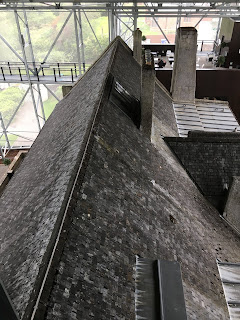This year I visited two houses designed by Charles Rennie Mackintosh. Both distinct experiences.
78 Derngate is
the only house in England designed by Mackintosh. It is well worth booking in
advance for a tour, as you will get to hear some interesting historical details
about the house. You will also be shown photographs of the house as it was many
years ago, and compare these with how the house has been sympathetically
restored today.
Before entering,
visitors are asked to wear plastic overshoes – as if going in to perform a
forensic examination. Once inside, you are allowed to move around the rooms
freely, without touching anything.
This townhouse is
designed to feel uncluttered even though it is remarkably narrow. Rooms are
stacked on top of each other on several floors in more or less this fashion:
one room at the front, one at the back, with staircase between.
The 1916 designs
– particularly of the front ground floor room and the guest bedroom – still
appear modern by today’s tastes over one hundred years after they were designed.
Later in the year
I visited The Hill House. Built in 1902-3, with further additions of
Mackintosh-designed furniture over the next ten years, I had wanted to see this
house for a very long time. When I had the opportunity to visit, I was
surprised to find out that it was shortly to reopen with a new conservation
project/visitor attraction called ‘The Box’. Upon close inspection, you will
see that the walls of the Box are a screen of steel mesh (like chain mail).
Originally, visitors would have been able to experience the sight of Hill House
against the Scottish landscape, but it looks likely that this view will be
denied for approximately ten years while the damp house dries out naturally,
shielded from the Scottish rain.
Although denied
this view, another experience has taken its place. There are walk ways around
and over the roof of the house, so that visitors can see the architecture from
several vantages. I thought perhaps, that the Box would spoil the visit to Hill
House, making it more of a gimmick. But I was not disappointed. Turning the
conservation work into an attraction itself has been advantageous because it
gives visitors such a unique opportunity to enjoy the house on many different
levels (literally as well as figuratively).
Once inside, it
is easy to ignore – nay forget – that the Box is situated outside, and
therefore the steel structure in no way affects the experience of walking
through the beautiful Mackintosh rooms.
I walked around the house a couple of
times and overheard another visitor say “I don’t want to leave”.
Who would?
Incidentally, items from the Hill House are sometimes loaned out to the Kelvingrove Art Gallery and Museum. This was the case on my visit. So I visited the latter to see Mackintosh's Kimono writing desk. Another beautiful item, and easy to envisage standing in the drawing room of Hill House on the opposite side of the fireplace to the settle.



























